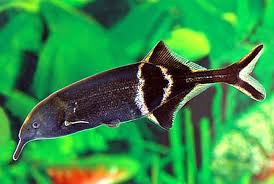Elephant Nose
Elephant Nose
check_circle Fast Shipping
check_circle Quality Products
check_circle Affordable Price
Reach out to us on ''available to order'' items via WhatsApp or email
20 in stock
Couldn't load pickup availability

Elephant Nose
package_2
Product Description
Product Description
Elephant Nose Fish
Description & Care (Bullet Form)
Description
-
Scientific name: Gnathonemus petersii.
-
Distinctive elongated trunk-like snout used for sensing and foraging—resembles an elephant’s trunk.
-
Sleek, dark brown to black body with pale vertical stripes near the tail.
-
Can grow 20–25 cm in captivity.
-
Uses weak electrical impulses to navigate and communicate—electric fish.
-
Intelligent, curious, and sensitive species.
Tank Requirements
-
Minimum tank size: 200 L for one or two fish; needs space to swim.
-
Soft, sandy substrate to protect delicate snout while foraging.
-
Water parameters: pH 6.0–7.2, soft to moderately soft water.
-
Temperature: 24–28 °C.
-
Needs excellent filtration, stable parameters, and very clean water.
-
Low to moderate lighting—prefers dim environments.
Aquascaping
-
Provide hiding spots: driftwood, tubes, caves, PVC pipes, and dense plants.
-
Dark substrate and shaded areas reduce stress.
-
Avoid sharp decor—delicate skin and snout.
Diet & Feeding
-
Carnivorous; feeds on worms, insect larvae, and small crustaceans.
-
Prefer live/frozen foods: bloodworms, blackworms, tubifex, mosquito larvae, brine shrimp.
-
Rarely eats pellets or flakes; may accept soft sinking foods over time.
-
Feed in evening or under dim light—nocturnal feeder.
Behavior & Compatibility
-
Peaceful but territorial with same species unless in large tanks.
-
Best kept singly or in groups of 5+ to spread aggression (requires very large tank).
-
Unsuitable tankmates: fast feeders and fin nippers (barbs, cichlids, tetras).
-
Good tankmates: peaceful, slow fish like discus, gouramis, Congo tetras.
Special Notes
-
Very sensitive to copper and most medications.
-
Cannot be used in newly set-up or unstable tanks.
-
Avoid strong water current—prefers calm or slow-moving water.
Breeding
-
Extremely rare in home aquariums; requires specialized breeding conditions.
-
Uses electric signals for courtship and communication.
Challenges
-
Difficult for beginners due to feeding needs, sensitivity, and intelligence.
-
Requires excellent water quality, calm tank, live foods.
Key Selling Points (for store use)
-
Unique “elephant trunk” nose and electric sensing—truly fascinating fish.
-
Intelligent, elegant, and captivating for advanced aquarists and display tanks.


